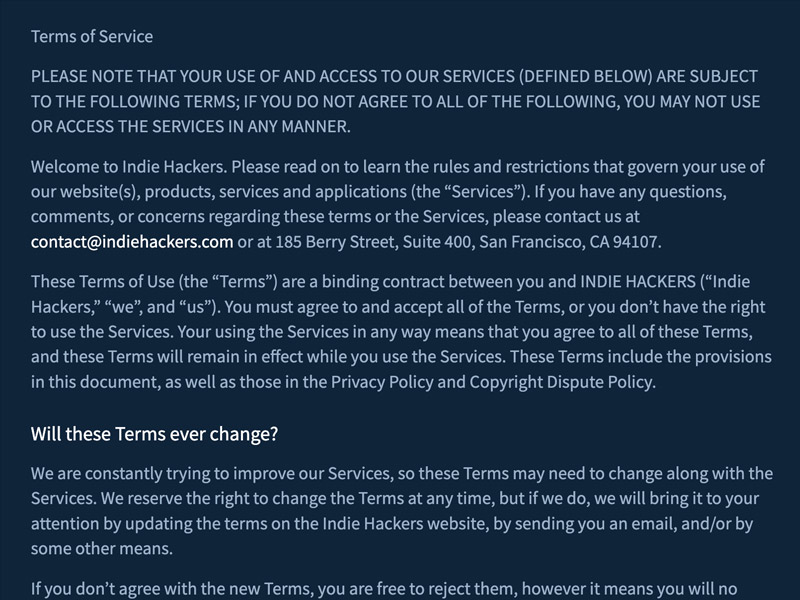The Minnesota Student Data Privacy Act (MSDPA)
The Minnesota Student Data Privacy Act (MSDPA)

Create a tailored Privacy Policy, Terms & more in under 5 minutes.

A high-level guide to writing Terms and Conditions for your website. By the end of the article, you’ll understand the legal implications and how you can best protect yourself and your business.
A Terms and Conditions statement is a page on your website that sets the rules straight with your website visitors and customers. Your website is your online home, so it is your responsibility to set the rules. You can do it by drawing out Terms and Conditions that will explain clearly how your website can and can’t be used.
You can determine the rules regarding the content and your intellectual property, the responsibility regarding the website content, what users with member accounts can do, and so on.
There is no substantial difference between Terms and Conditions and an Agreement. In fact, your Terms and Conditions are the agreement between you and your users about using your website or your app.
As a website owner, you offer website visitors and customers an agreement. They can get all the benefits your website offers but under certain rules. Users can choose either to remain on the website and respect the rules or leave.
Website visitors who stay on the website and keep browsing around it imply that they agree with your terms. You don’t need to care whether they read it or not – it is their own responsibility to do so. Your job is to post the terms on the first page they arrive. That’s why it is a best practice to include a link in the footer since it appears on whatever page the user has landed.
Terms and Conditions could serve as a purchase agreement when you have something to sell. In such a case, the user needs to sign the agreement. In online sales, it is enough to clickwrap the agreement through a checkbox. The user will check the checkbox and confirm that they read the terms. Again, it is up to the user to choose whether to read the terms or not. It is their own responsibility.
Clickwrapping the agreement between you and your user is important because it will allow you two things:
No, Terms and Conditions are not legally required, but it is nice to have one.
No single law worldwide explicitly requires a website to have terms. It means that you can operate your website without any contracts in place.
However, it’s not recommended. As mentioned above, you want to set the rules for your website. Having no Terms and Conditions means there are no rules, and you have not set your expectations straight with the users.
Even worse, selling something online without terms that serve as a purchase agreement could get you into trouble. If the buyer is unhappy with the product, they may ask for a refund, return the product, and so on. In the worst-case scenario, they may initiate a lawsuit against you if they suffer damages. Well-crafted terms and conditions could be lifesaving for your business. With the right provisions on limitation of liability and governing law, you’ll shield your business from frivolous lawsuits and have peace of mind.
Website operators often wonder about the best way to create their Terms and Conditions, and there are a few options. You can choose between:
In the next few paragraphs, we’ll dive deeper into the pros and cons of each one.
If you are good at drafting contracts, you can write your own Terms and Conditions. However, if you’re not a lawyer or have experience writing contracts, you should probably avoid it.
People who write their own Terms and Conditions usually go that way because they want to save money. Most often, they would copy the terms of a competitor and maybe rewrite them.
This is a bad idea for two reasons:
The Do-It-Yourself approach works only for people who know what they do. It is not wise to draft your own terms if you don’t know how to do so. There are too many risks involved. Instead of protecting you, your Terms and Conditions may hurt your business.
If you have the resources to afford a lawyer to draft the terms for you, this is often the best option. Lawyers who work with online businesses know the risks you may face and will protect you.
The downside of hiring a lawyer is the price. Your terms could easily cost thousands of dollars. Hiring a lawyer can be expensive and they often use contract templates for their services anyway.
Website Terms and Conditions generators bring the best of both worlds. They use templates drafted and vetted by lawyers, users’ input on the business, and generate terms as if a human would have drafted them.
As we discussed above, lawyers regularly use templates in their work. When creating website terms, they just fill in the blanks to fit the type of business they work with.
Generators do the same: you input your business information the same way you would inform a lawyer about it, and the generator creates the terms to fit your business.
Generators provide small businesses with a simpler, more affordable option. Instead of costing thousands of dollars, generators like GetTerms can provide you with the documents you need for a small monthly fee.
Although generating your website Terms and Conditions with GetTerms seems like a no-brainer, if you still want to learn what to write in your terms or to check out if your lawyer’s or your generator’s terms are good enough.
The content of your Terms and Conditions depends on the type of business you run. SAAS, eCommerce, blogs, and marketplaces are all different and require different approaches.
Nevertheless, all of them share the same essential elements:
Your Details. The name of your company (or the website, if you have not incorporated it yet), your email address, and your physical address (if any), should be part of the Terms and Conditions.
The Product or Service. The terms need to describe well the product or service that you offer. You don’t have to go into granular detail, but you need to specify what your users get. A well-crafted Products/Services section will save you lots of headaches down the road.
If you collect any personal information from users to provide services, clearly state what categories of data are necessary to execute the agreement.
For ecommerce stores, that would be the personal name, email address, delivery address, and maybe the phone number. Membership websites, in most cases, require only a personal name, location, and email address. SaaS companies may require a wide range of personal information depending on the app features.
Clearly stating the personal data required for the execution of the agreement will allow you to process such data without additional consent if strict privacy laws such as the GDPR apply to your business.
Prohibited Uses. It is important to have clear guidelines for users on your website to maintain a clean and safe environment. This section will outline what is not allowed on your website, and if a user violates these guidelines, you will be able to terminate their agreement with you. This could be anything from abusive behavior in your membership area, violating your intellectual property, or installing malware on your website.
Privacy. This section is unnecessary, but you can add it for clarification. It suffices only to mention that you take care of users’ privacy and refer them to the privacy policy. Remember that accepting the terms does not mean that users necessarily accept your privacy policy.
Intellectual Property. This is the part where you need to list all the prohibitions related to the use of your intellectual property available on the website. It is a standard set of prohibitions.
Disclaimers, Indemnification, and Limitation of Liability. These clauses are also standard across many websites. Their purpose is to protect you in the case of a lawsuit by limiting your liability up to a certain amount of money, which is usually low.
Termination and Cancellation. It’s important to be clear about the circumstances under which you’ll terminate a user’s agreement with you. In most cases, you’ll take action if the user breaches any of the terms of the agreement or misbehaves in a way that negatively impacts your business. However, there are some cases where you may need to terminate an agreement even if the user is following all of the terms. This is especially true if the user uses your product or service to violate your terms or create a risk for you or others. If the user disputes the termination with a lawsuit, this section and the Prohibited Uses section will come in handy.
Governing Law and Dispute Resolution. Contract parties are free to choose the governing law to apply to the contract. This is particularly important in the case of a dispute. That is why online businesses tend to choose their home state and/or home country’s law as governing law and home state or country courts to be competent for the dispute.
Remember that this is not an exhaustive list of everything your Terms and Conditions template should contain. We cover the essentials, but the Terms and Conditions you create needs to be aligned with the purpose of your website.
Copying other websites’ Terms and Conditions is never a good idea, but taking inspiration doesn’t hurt. Let’s have a look at a few examples to give you an idea of the possibilities.
Google has one of the best legal teams in the world. Helped by their UI/UX designers, they created Google Terms and Conditions to be clear, concise and easily understandable for everyone. At the same time, it protects them from legal scrutiny from all around the world.

If you are curious about writing Terms and Conditions, diving deep into Google’s terms is a great idea.
Indie Hackers’ terms are written mainly in plain language, but some legalese terminology here and here to ensure protection for the company. They pay special attention to the rules around user-generated content and intellectual property.

500px combines legalese, plain language, and UX design in its Terms and Conditions. The terms are separated into two columns: one in legalese and one in plain language.

They have separate Content Guidelines, and the terms only refer to those guidelines. They have not included the actual guidelines in the terms, which is perfectly fine.
Instagram Terms of Use excel in plain language. It is a legal document that is nice to read.

The focus of the terms is put on prohibited uses of the platform (they call it How You Can’t Use Instagram) and the permissions you, as a user, give to them.
Juro provides lawyers with contract automation tools. Considering that their user base is made of lawyers, it is no surprise that their Terms and Conditions are heavy on legalese. They are written by lawyers exclusively for other lawyers’ eyes.

It couldn’t get more legalese than this, but for a good reason.
There are numerous ways to create your Terms and Conditions Template and you need to decide the best option for you. If you can’t afford a lawyer, consider using a service like ours to generate your Terms and Conditions in less than 5 minutes.